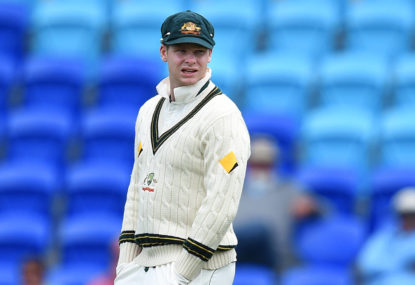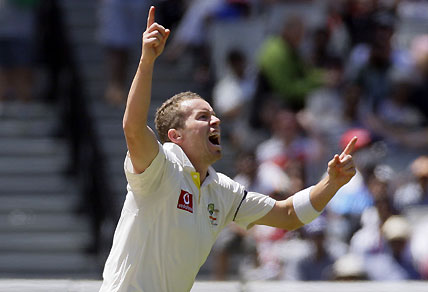WATCH: Stumps a mess as Rajasthan Royals opener gets ramp shot horribly wrong
Yashasvi Jaiswal was looking comfortable at 67 off 40, until this moment when he hit the ball into his own stumps!

The Australian cricket team is going through a massive form slump, with the team losing its last five Test matches, and last five one day international (ODI) matches.
This has resulted in many questions being asked of the team, and Cricket Australia at a number of different levels, and there is no right, or wrong answer to solving the struggles that face the Australian Cricket Team.
However, this what I think should happen within Cricket Australia in regards to the Australian Cricket Team.
Firstly, the reliance on the scientific approach to fast bowler/bowling management must be brought to a close immediately, which means that Pat Howard in his job as the general manager of high performance at Cricket Australia is no longer required.
The scientific approach to player management is completely flawed, and it has resulted in an approach of over-thinking the selection of the Australian team, meaning that the best team, especially in Test match cricket, isn’t being selected.
Some fast bowlers, like Mitchell Starc, trigger Pat Howard’s bowling management red flags, meaning that he has a higher risk at that particular time of suffering an injury. The only problem with that is that he isn’t getting injured. In fact, I don’t think Cricket Australia are pushing the fast bowlers in this country at a young enough age for hard enough for long enough.
In addition to this, other fast bowlers who aren’t triggering red flags within their system are suffering serious injuries, especially back injuries, on a regular basis, and unexpectedly, like Peter Siddle, which in my mind supports the case of the fast bowlers not being pushed to their absolute limits in training, and even in match mode.

So, what policies could be put in place to make sure fast bowlers are fit before returning to international level?
My proposal would be for fast bowlers, especially in regards to coming back from lower-back stress fractures to play in ten first-class matches, six List A matches, and four Twenty20 matches, or an equivalent amount of matches in a certain format(s) of the game without getting seriously injured before they are eligible to play for Australia in any format of the game again.
Secondly, the national selection panel and the coaching structure of the Australian Cricket Team needs to be overhauled immediately.
This overhaul would include the termination of the contracts of Rod Marsh (national selection panel chairman), who has now resigned from his role, Mark Waugh (national selector), and Darren Lehmann (both as head coach and national selector) due to a number of reasons including poor performance, inability to look ahead to the future, lack of understanding of modern-day cricket, and conflicts of interest, which include media commitments and close family relations with the potential of being selected in the not too distant future.

The only member remaining on the national selection panel would be Trevor Hohns, who would become the new chairman of the national selection panel, and this panel would be reduced to a three-person panel, and will be responsible for picking the Australian Cricket Team in all forms of the game.
The new members of the national selection panel would have an intimate understanding of the modern game, and ideally have been removed from the game for at least ten years, but that won’t be a compulsory requirement.
The Test team, for example, will be selected on the basis of having six specialist batsman, one wicket-keeper, and four bowlers (with at least two fast bowlers, one spinner, and another bowling option to allow for flexibility in certain conditions), and if one or more of those players can offer something extra to the team, well then that’s a bonus.
The national selection panel will then select the team, and the players who are selected by each member of the panel will be guaranteed a start in the team/squad. The spots in the team/squad that are deemed not to be unanimous according to the national selection panel will then be decided by the captain and the head coach of the team out of the names in contention as deemed by the national selection panel (unless either the captain and/or head coach has a player in mind to fill the spot.
If both the captain and head coach fail to come to an unanimous decision in regards to selection issues, then the chairman of the national selection panel will select the remaining spots of the team/squad.
This will give all relevant people an opportunity to have their say on who should be in the Australian side
In addition to this, the coaching structure within the team will change. The only specialist coaches remaining with the team full-time, with the exception of medical staff and fitness coaches, will be the head coach, the fielding coach, and a specialist coach who deals with running between the wickets, and communication.
The new coaching structure will include a new and independent pool of batting and bowling coaches, who will all have links to all levels of cricket in Australia, and players will have the opportunity to seek out any of these coaches for their advice and expertise.
Thirdly, there will be a policy of promoting and selecting younger players (Under 25) who have met certain requirements, particularly in first-class cricket, before they are selected to play Test match cricket for Australia. This includes the amount of first-class matches played (minimum of 20 matches), batting, bowling or fielding averages, and current form.
Fourthly, there will be higher standards for players 25 years of age or older, and they must prove high standards of excellence with bat, ball or in the field on a consistent basis to prove themselves to being of international standard.
Fifthly, the captain of the Australian cricket team, who in this case is Steve Smith, will be the player who will lead team culture, and the general approach of how the Australian Cricket Team plays going forward.
Within this context, my advice to Smith would be for him to channel his inner ‘Captain Grumpy’ to motivate his team to be successful. Last year, the media noted to Smith in a press conference that he was a little bit grumpy out on the field to his players, and he had success. Since then, he has been less grumpy, and the results have gone downhill.
In conclusion, with my suggestions being implemented, the Australian Cricket Team and the game in Australia in general will be great once again.